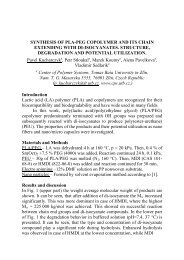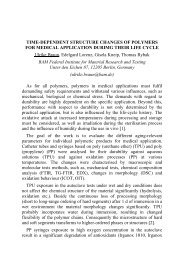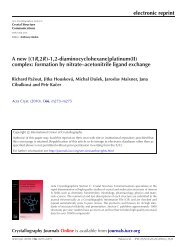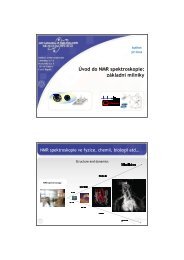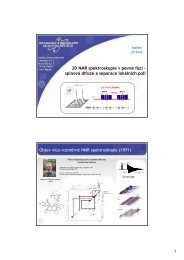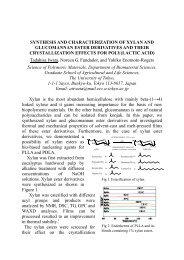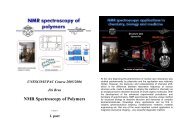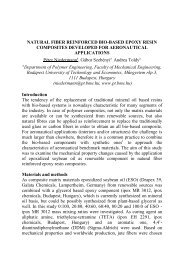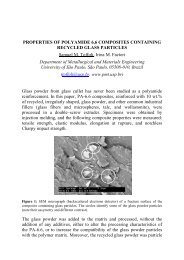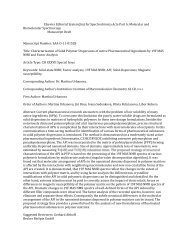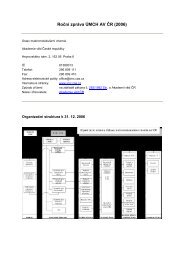Toughening of unsaturated polyester resins by reacting additives
Toughening of unsaturated polyester resins by reacting additives
Toughening of unsaturated polyester resins by reacting additives
Create successful ePaper yourself
Turn your PDF publications into a flip-book with our unique Google optimized e-Paper software.
TOUGHENIG OF UNSATURATED POLYESTER RESINS<br />
BY REACTING ADDITIVES<br />
Boris Gorelik a<br />
a MOBIChem Scientific Engineering Ltd., 19 Hartum St, Har Hotzvim,<br />
91451, Jerusalem, Israel (borisg@mobichem-sci.com)<br />
Thermosetting materials based on Unsaturated Polyesters (UPR) are<br />
known to possess very low ductility. This means external energy applied<br />
on UPR (e.g. impact) has low chance to be dissipated as it occurs in<br />
rubbery materials, but is consumed on formation <strong>of</strong> cracks propagating<br />
fast from impact point to surrounding regions. Thus many attempts to<br />
apply reactive elastomers like CTBN did not lead to appropriate<br />
toughness <strong>of</strong> UPR <strong>resins</strong>. The same results were obtained for core-shell<br />
systems (Albidurs <strong>by</strong> Nanoresin) or nano-structured block-copolymers<br />
Arkema. The presence <strong>of</strong> reactive groups to link toughening agents to<br />
UPR structure did not show any visible effect on toughening <strong>of</strong> UPR<br />
used. On the other hand all above toughening agents showed good<br />
enough toughening effect in case we applied them in epoxy resin based<br />
composites. Low ductility means matrix <strong>of</strong> very low viscous properties<br />
and very low relaxation time. Within relaxation time period excitation is<br />
able to propagate to some distance from point <strong>of</strong> excitation to form crack<br />
or to be retarded <strong>by</strong> toughener. Basing on above approach we can<br />
consider polymer matrix as divided in elementary unit volumes. Each<br />
volume unit has to contain toughening element which is responsible for<br />
toughening <strong>of</strong> UPR matrix located in vicinity. The idea can be realized<br />
<strong>by</strong> using toughening <strong>additives</strong> <strong>of</strong> very low size to endeavor to fight with<br />
low relaxation time <strong>of</strong> extremely low ductile UPR matrix. In this regard<br />
the less is the toughening unit the better is toughening capacity.<br />
<strong>Toughening</strong> is only possible in case toughening additive exists as<br />
separated phase in solid UPR matrix. In case single phase solution <strong>of</strong><br />
toughening additive in rigid matrix never toughening effect was observed.<br />
The main target <strong>of</strong> the work was to follow influence <strong>of</strong> epoxy toughener<br />
on properties <strong>of</strong> UPR. In contrast to classical toughening agents<br />
toughening effect <strong>of</strong> thermosets shows maximum upon concentration<br />
close to 0.1mol/kg <strong>of</strong> additive. Concentration <strong>of</strong> epoxy groups in<br />
toughening additive must be close to concentration <strong>of</strong> –OH and COOH<br />
end groups in UPR. In case <strong>of</strong> lower concentration it is not enough epoxy
groups to link all UPR end groups. In case <strong>of</strong> higher concentration <strong>of</strong><br />
epoxy groups not all epoxy groups are reacted or polymerization <strong>of</strong> epoxy<br />
groups can take place. Reaction <strong>of</strong> epoxy with Unsaturated Polyester end<br />
groups can decrease entropy change <strong>of</strong> solution <strong>of</strong> epoxy in UPR before<br />
and after reaction <strong>of</strong> epoxy groups with UPR ending groups. The number<br />
<strong>of</strong> possible states <strong>of</strong> linked epoxy is much less than numbers <strong>of</strong> possible<br />
states which in free epoxy can exist. It means:<br />
ΔG l = ΔH l - TΔS l ( liquid phase) (1)<br />
ΔG s = ΔH s – TΔS s ( solid phase) (2)<br />
ΔS s < ΔS l (3)<br />
The main target to obtain toughened system is:<br />
ΔG l < 0 and ΔG s > 0 (4)<br />
In general terms epoxy structure interior UPR matrix can be related to<br />
interpenetrated network (IPN). Such toughening effect is related not to<br />
particular epoxy resin application but to formation <strong>of</strong> toughening IPN in<br />
UPR matrix <strong>by</strong> monomer <strong>of</strong> higher ductility. As mentioned above<br />
toughened polymer can be divided in elementary volumes each<br />
containing one toughening phase separated unit. Dimensions <strong>of</strong><br />
elementary volume for regular rubbery toughening agents (about<br />
0.5mcm) is likely large to provide effective transfer <strong>of</strong> exciting energy<br />
from UPR matrix to elastic polymer. Molecular level distances in IPR<br />
provide good toughening effect <strong>by</strong> very short time <strong>of</strong> energy transfer<br />
compared to relaxation time in UPR. Below are a few results <strong>of</strong><br />
application <strong>of</strong> epoxy resin as toughening agent compared to regular<br />
toughening system in highly filled (87%w/w quartz) UPR composite.<br />
<strong>Toughening</strong> effect <strong>of</strong> different <strong>additives</strong> on filled (87% quartz) UPR<br />
Epoxy toughener,<br />
0.1mol/kg, 3-functional<br />
Albidur, Core-Shell,<br />
toughener, 12%<br />
Unmodified UPR<br />
composite<br />
82.0 52.0 78.0 Ultimate Strength<br />
2.2 1.0 1.0 Impact Strength, AU<br />
91.4 81.0 9230 Tg, C



